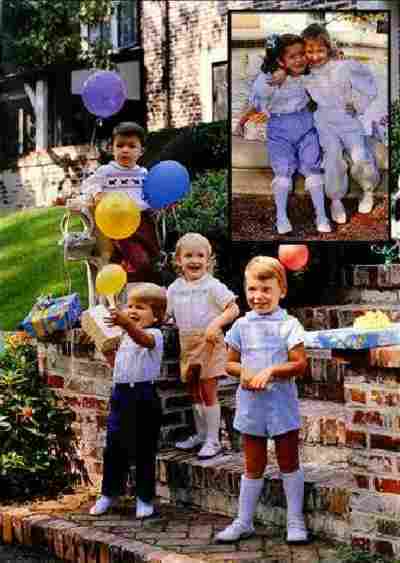
Figure 1.--Button-on suits, often with lively smocked designs, are popular summer outfits for boys. Theybaremost commonly short pants outfits, but also come in knickers and long pants. |

|
Button-on outfits for younger boys have varied in popularity over time. Skeleton suits worm in the early 19th century were button-on outfits. We see a range of button-on outfits worn in the mid-19th century Button on suits were one of the many styles of clothing that developed for boys beginning in the 1910s as fewer and fewer boys wore dresses when they were younger. The button-on suits might be matching or coordinated blouses and pants. The pants were held on by buttons at the waist of the blouse that fitted into button holes in the pants. Yoing boys are very active and with their slender waists, keeping up their pants could be quite a proble. It was these buttons that conveniently kept the pants up rather than suspender arrangements or belts.
Button-on outfits for younger boys have varied in popularity over time. Skeleton suits worn in the early-19th century were button-on outfits. They went out of style before photography was invented. Paintings provide many exmples. And subequenly We have many images of the button-on outfits popular in the mid-19th century. We see a range of button-on outfits worn in the mid-19th century. A good example is the outfit worn by American boy C. Stewart in 1865. Another example is C.C. Ellis about 1870. Another example is the suit sworn by Andrew Richardson in 1875. These suitslook rather like one piece jumpsuits, but waut bands his the buttons connecting the jacket and trousers. Button on suits were one of the many styles of clothing that developed for boys beginning in the 1910s as fewer and fewer boys wore dresses when they were younger.
Nutton on outfits were very popular in the 1920s. We note an unidentified Texas boy wearing a button-on sailor suit in 1924.
We note an unidentified American boy wearing a button-on suit in the late-1920s. Another good example is Atril D. Taylor in 1926. hese boys are wearing play clothes.
This would have been a dressy outfit for the boy. Note how different they were from the fussy format outfits of the 19th century. Button-on suits declined after he 1940s. We till see them oday, but hey tend to be dressy outfits sold at botique shops. The outfits here are a good example (figure 1).
The buttons on these suits could be quite large. This was of course to makeit easier for young boys to dress themselves. Quite large buttons could be seen in the 1910s and 20s, even in the 1930s. Currently more normal sized buttons are worn.
Button on suits were generally made for younger boys. Generally they were worn by boys up to about 4 or 5 years of age, but suits were occasionally sized up to 6 or even 7 years of age. This was especially true in the earlier ages when a boy up to about 8 or even older might have worn a fancy button-on velvet sduit. The age of the boys wearing them has fallen since the 1960s. Usually boys younger than 5 are the primary omes wearing them in the 1990s. Occasionally an older boy at a formal wedding might wear a fancy button-on suit. They are almost never one for play by th 1990s.
We notice button-on outfits being worn in both Europe and North America. We have, however, only begun to assess country trends. We do nnote these outfits in America, England, France, asnd Germany. We believe that they were common in many other European countries, but our archives for many of those countries is very limited.
The styling for these suits vairred widely. These button-on suits were made as both play suits and as dress up outfits.
Button-on play suits seem to have appeared in the 1910s. The first button-on suits seem to have been primaruly play suits. Dressy suits in this style are not commonly seen until the 1930s.
Most mothers did not think an adult looking suit was suitable for really young children although you do see that in the 1990s. Buttonms-on suits began to appear in dressy styles by the 1930s, They were often worn by boys before they started to wear Eton suits. Some boys even wore them instead of the Eton suits. hey are less common in the 1990s, but still seen for dressy occasions.
One fancy dressy style which developed in the 1950s was smocked collars, either worn on blouses or over fancy velvet jackets. Often these blouses were worn as button-on suits, smocked blouses with waist buttons that were worn with matching short pants, knickers, or long pants with button holes for the blouse buttons. The blouses thus could be worn without suspenders-style pants that would hide the smocking work.
Through the 1940s, boys short pants were available on the button-style for bous through age 10. These were usually not button-on suits syled for younger children. The shorts and short pants suits were styled like normal shorts or suits, only they were available in the bitton-on style.
Navigate the Boys' Historical Clothing Web Site:
[Return to the Main button-on page]
[Introduction]
[Activities]
[Biographies]
[Chronology]
[Cloth and textiles]
[Clothing styles]
[Countries]
[Topics]
[Bibliographies]
[Contributions]
[FAQs]
[Glossaries]
[Images]
[Links]
[Registration]
[Tools]
[Boys' Clothing Home]
